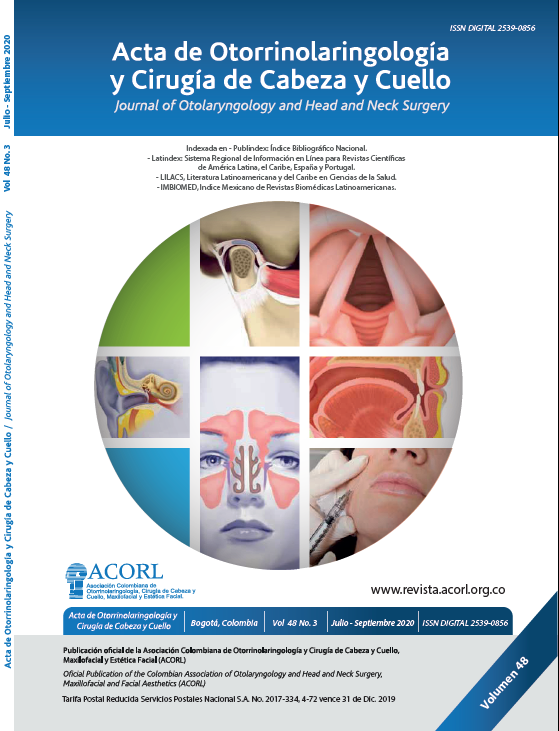Evaluación de los desenlaces posoperatorios de los pacientes sometidos a septoplastia y turbinoplastia entre los años 2016 a 2018 de la Fundación Santa Fe de Bogotá
Contenido principal del artículo
Resumen
RESUMEN
Introducción
La tasa de infección después de la cirugía nasal electiva es muy baja, lo que hace que la profilaxis antibiótica de rutina sea redundante. En Colombia no disponemos de información acerca de la tasa de infección de septoplastia; por esta razón, en este artículo se busca describir la tasa de infección posquirúrgica en los pacientes llevados a septoplastia o septoplastia y turbinoplastia de la Fundación Santa Fe de Bogotá, entre los años 2016-2018. Metodología: se realizó un estudio observacional, descriptivo y retrospectivo mediante la revisión de la base de datos del servicio. Se calculó la proporción de infección para todos los individuos participan tes del estudio de manera general y estratificada por el uso de antibiótico profiláctico y posoperatorio, y se describió la frecuencia de las complicaciones. Resultados: encontramos 255 pacientes en la base de datos de la sección de otorrinolaringología, de los cuales 206 cumplieron con los criterios de inclusión. El 23,3 % de los pacientes recibió un antibiótico profiláctico y el 24,76 % recibió un antibiótico postoperatorio. La tasa de infección posoperatoria fue de 2,91 % (intervalo de confianza [IC] del 95
%: 1,07-6,23). El 96,6 % de los pacientes no presentaron complicaciones. Conclusiones: nuestros hallazgos se correlacionan con la literatura global.
Detalles del artículo
Sección

Esta obra está bajo una licencia internacional Creative Commons Atribución-CompartirIgual 4.0.
Este artículo es publicado por la Revista Acta de Otorrinolaringología & Cirugía de Cabeza y Cuello.
Este es un artículo de acceso abierto, distribuido bajo los términos de la LicenciaCreativeCommons Atribución-CompartirIgual 4.0 Internacional.( http://creativecommons.org/licenses/by-sa/4.0/), que permite el uso no comercial, distribución y reproducción en cualquier medio, siempre que la obra original sea debidamente citada.
eISSN: 2539-0856
ISSN: 0120-8411
Cómo citar
Referencias
1. Georgiou I, Farber N, Mendes D, Winkler E. The role of antibiotics in rhinoplasty and septoplasty: a literature review. Rhinology. 2008;46(4):267-270.
2. Wiesmiller K, Keck T, Rettinger G, Leiacker R, Dzida R, Lindemann J. Nasal air conditioning in patients before and after septoplasty with bilateral turbinoplasty. Laryngoscope.2006;116(6):890-894. doi:10.1097/01.mlg.0000201995.02171.ea
3. Ismi O, Ozcan C, Vay?so?lu Y, Öztürk C, Tek SA, Görür K. Transseptal suturing technique in septoplasty: impact on bacteremia and nosocomial colonization. Eur Arch Otorhinolaryngol. 2017;274(5):2189-2195. doi:10.1007/ s00405-017-4479-x
4. Rhee JS, Book DT, Burzynski M, Smith TL. Quality of life assessment in nasal airway obstruction. Laryngoscope. 2003;113(7):1118-1122. doi:10.1097/00005537-200307000-00004
5. Krouse JH. The unified airway--conceptual framework. Otolaryngol Clin North Am. 2008;41(2):257-v. doi:10.1016/j.otc.2007.11.002
6. Moche JA, Palmer O. Surgical management of nasal obstruction.Oral Maxillofac Surg Clin North Am. 2012;24(2):229-viii.doi:10.1016/j.coms.2012.01.013
7. Chandra RK, Patadia MO, Raviv J. Diagnosis of nasal airway obstruction. Otolaryngol Clin North Am. 2009;42(2):207-vii.doi:10.1016/j.otc.2009.01.004
8. Colsanitas, 2019 [Nota: por favor suministrar los datos completos de esta referencia]
9. D?browska-Bie? J, Skar?y?ski PH, Gwizdalska I, ?az?cka K, Skar?y?ski H. Complications in septoplasty based on a large group of 5639 patients. Eur Arch Otorhinolaryngol.2018; 275(7): 1789–1794. Published online 2018 May 16. doi:10.1007/s00405-018-4990-8





